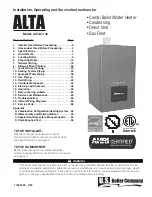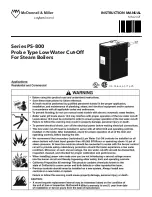
Part number 550-100-305/0916
72
AquaBalance
TM
W
ALL
M
OUNT
GAS
-
FIRED
WATER
BOILER
— C
OMBI
Boiler Manual
32
Troubleshooting
(continued)
Temp
(°F)
Sensor ohms
Temp
(°F)
Sensor ohms
Temp
(°F)
Sensor ohms
Min
Max
Min
Max
Min
Max
32
31530
33480
100
5608
5954
170
1344
1428
40
25792
27388
110
4590
4874
180
1143
1213
50
19258
20450
120
3636
3860
190
945
1003
60
15218
16160
130
3011
3197
200
810
860
70
11577
12293
140
2417
2567
212
657
697
80
8891
9441
150
1954
2074
-
-
-
90
7185
7629
160
1644
1746
-
-
-
Check flame signal
1. Navigate to Diagnostics/Inputs on the control display (see
pages 50 to 54 for navigation instructions.
2. The flame signal value must be at least 25 on low fire. The
flame signal value must be at least 255 on high fire, reading
at times 10 equals microamps of flame signal. If the flame
signal drops below this level, the control will attempt to cor-
rect by increasing the blower speed to increase flame signal.
3. A low flame signal may indicate a fouled ignitor or damaged
ignitor cable insulation.
a. See “Inspect ignition electrode,” page 84 to remove and
inspect the ignitor.
b. If required, clean the ignitor and flame rod as in-
structed, see page 84.
c. If cleaning the ignitor does not improve, ground wiring
is in good condition, and ground continuity is satisfac-
tory, replace the ignitor.
4. If flame signal still remains low:
a. Inspect the vent and air piping.
b. Check combustion values.
c. Then inspect the heat exchanger, following the proce-
dures given in this manual for inspecting and clean-
ing of the heat exchanger cover plate and other boiler
components (starting on page 84).
d. Clean the heat exchanger as described in this manual if
necessary, see page 87.
Check control fuse
ALWAYS check circuit fuses before replacing
control or any major components (blower,
etc.). If a fuse is blown, it can prevent the con-
trol or other components from operating.
1. Turn OFF power to boiler at external line switch. Then
remove the jacket door.
2. Locate fuses using Figure 92 and Figure 93.
3. Remove and inspect the fuses (Item a, Figure 92 or Item
b, Figure 93).
4. If necessary, replace the fuses:
a. Control circuit fuse is a 250 VAC 3.15-amp rated
fuse. (Littelfuse 326012P)
b. Thermostat-relay circuit fuse is a 250 Volt 630mA rated
fuse. (Littelfuse 071-852 Type 5 x 20mm).
Do not jumper fuses or replace with any fuse
except as specified. Failure to comply could result
in severe personal injury, death or substantial
property damage.
Checking temperature sensors
1. The boiler temperature sensors (flue, outdoor, return
water and supply water) are all resistance-type devices.
Figure 94 shows the correct value for the sensor at various
temperatures. For dual sensors, the temperature difference
between the sensors must be no more than 10 °F. (Supply
outlet 200 sensor).
2. Use the resistance values at 32°F, 60°F, 70°F and 212°F to
measure the sensor resistance at known temperatures (ice
point, room temperature and sea level boiling point). For
ice point and boiling point, insert the sensor in water at
that temperature. Use an ohmmeter to read resistance value.
3. To check whether the control is correctly sensing temperature,
you can use a resistance decade box. Connect the decade box
temporarily in place of a sensor and read the corresponding
temperature on the control display. The temperature should
be close to the value corresponding to the input resistance.
Figure 92
#ONTROLCIRCUITFUSELOCATION
Figure 93
4HERMOSTATRELAYCIRCUITFUSELOCATION
Figure 94
3ENSORRESISTANCESVALUES
Installer/homeowner note,
in case of an “open circuit”
of the Thermostat-relay
fuse the boiler can run in
DHW mode but NOT in
Central Heating mode.
Fuse located on rear of circuit board
a
b
















































